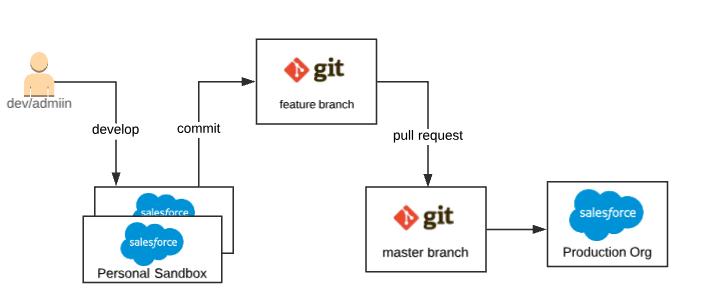
Do you know what, to make progress in adopting Salesforce source control and release management, organizations ought to pursue various core values that probably won’t be commonly required in other programming advancement stacks. Each organization will have diverse release prerequisites and cultures, however as long as you remain within the accepted or you can say the best practices of Release management, you ought to have no issues in moving towards an increasingly streamlined, mechanized and present-day Salesforce release management procedure.
The quickness of advancement is continually overwhelming the speed in which we can convey. With an ever-increasing number of tasks in the pipeline, this gap is becoming more and more extensive. Does this trigger a discussion about how to deploy the best Salesforce solutions? The answer lies in streamlined Salesforce Release management. Today we shall discuss the best practices of the Salesforce Release Management Culture. Let us go through the practices required to simplify it. Here are some of the best practices of maintaining an excellent Salesforce Release Management.
Feature branching and pull demand is an industry standard for working with Git, yet despite everything, we see groups working off shared branches and carefully choose commits on creation. If in you wind up in the way where you have to proceed with carefully selecting submits and applying hotfixes, your procedure should be revised in that case.

Every one of your engineers/administrators should chip away at his/her very own sandbox and submit changes to a component branch which speaks to a business change (Jira ticket, business demand). This component branch will, at that point, be converged to incorporation branches before getting conveyed in targeted environments.
Designs like validation rules, work processes, objects, and fields are similarly significant as Apex code and lightning segments. By and by, we’ve seen groups who chosen to follow just code in their archives, and this is a certain way to an ineffective discharge the boarding procedure. Ensure you track the two setups and code in your Salesforce repository.
This isn’t something to be surrounded by a document. It should be deliberately implemented. What’s more, the best way to implement this is to frequently deploy from your Git repository to your Salesforce production instance in a programmed manner.

The best execution of this is to set up a constant combination work that sends from your Git Repository to your creation case once a day. Any attempts to make changes straightforwardly underway (present another contending wellspring of truth) will naturally be returned the following day the nonstop combination work commences. This sets your whole group in a place where everybody needs to regard the release management procedure, and dependably makes changes in Git first before creation.
We’ve seen numerous groups store everything in Git; however, just convey a subset to creation. To a point where these groups never again have the certainty to send the whole ace branch to the creation in dread of overwriting more up to date changes underway.
Keep in mind that your Git archive must be a functioning and deplorable wellspring of truth and not be mistaken for a reinforcement. For the correct reason, you can choose not to follow profiles and page designs in your git storehouse as the dynamic wellspring of truth (not to mistake for reinforcement), however, on the off chance that you’ve settled on this choice, you should expel them from your Git archive totally. This likewise encourages your group to effortlessly match up to their sandboxes by just conveying expert branch to their sandboxes without seeing sending mistakes.
Your optimal form pipeline, stretching methodology, and discharge the executive’s procedure will be somewhat unique, relying upon the size and multifaceted nature of your Salesforce condition. Be that as it may, as long as you pursue the above-prescribed procedures, you are a stage on top of things in moving your group towards a progressively streamlined, present day and mechanized Salesforce release management procedure
For certain individuals, the organization isn’t an issue, since they work straightforwardly in their creation condition, which implies they never need to convey. This can be a brisk and productive method for working for certain organizations. It bodes well if, for instance, you don’t have adequate customization of your association to require an improvement group, or if you have to downplay costs, as there’s no requirement for independent advancement or organizing conditions. In any case, there’s dependably a hazard related with working straightforwardly underway, because you’re successfully making changes to the live association that is being utilized by your business once a day. This implies you should be sure that the progressions you’re making won’t break anything.
When you’re changing your advancement procedure, it’s imperative to get an arrangement set up for overseeing source control. It is safe to say that you are utilizing any sort of source control today? How are groups registering their work back with source control? Where and how do code audits occur? Do you have to confine access to specific branches or conditions? How does automation like Continuous Integration/Continuous Delivery sway your application management lifecycle?
In case you’re new to source control, ensure your group is getting a stronghold of the essentials. A decent spot to begin is the Git and GitHub Basics Module. Next, you have to assess how you’re organizing reports and branches inside your repositories. On the off chance that you have an important arrangement set up for source control and stretching, it can improve your day by day application advancement work processes. This applies to opened bundles, however advancement as a rule.
Release Management gives a structure to control when and where changes are advanced, starting with one Salesforce association then onto the next. This expands on deployment management, which sees how to move a change from one association to another. This is the reason why Salesforce Release Management is very necessary, and you need to adopt every best practice to make it effective for your organization. We are always open to constructive criticism. If there is anything that you would want to share with us, please leave it in the comments section below.
Stop, read and acquire deep insights into complex issues
© 2025 Copyright - JanBask.com | Designed by - JanBask Digital Design
Write a Comment